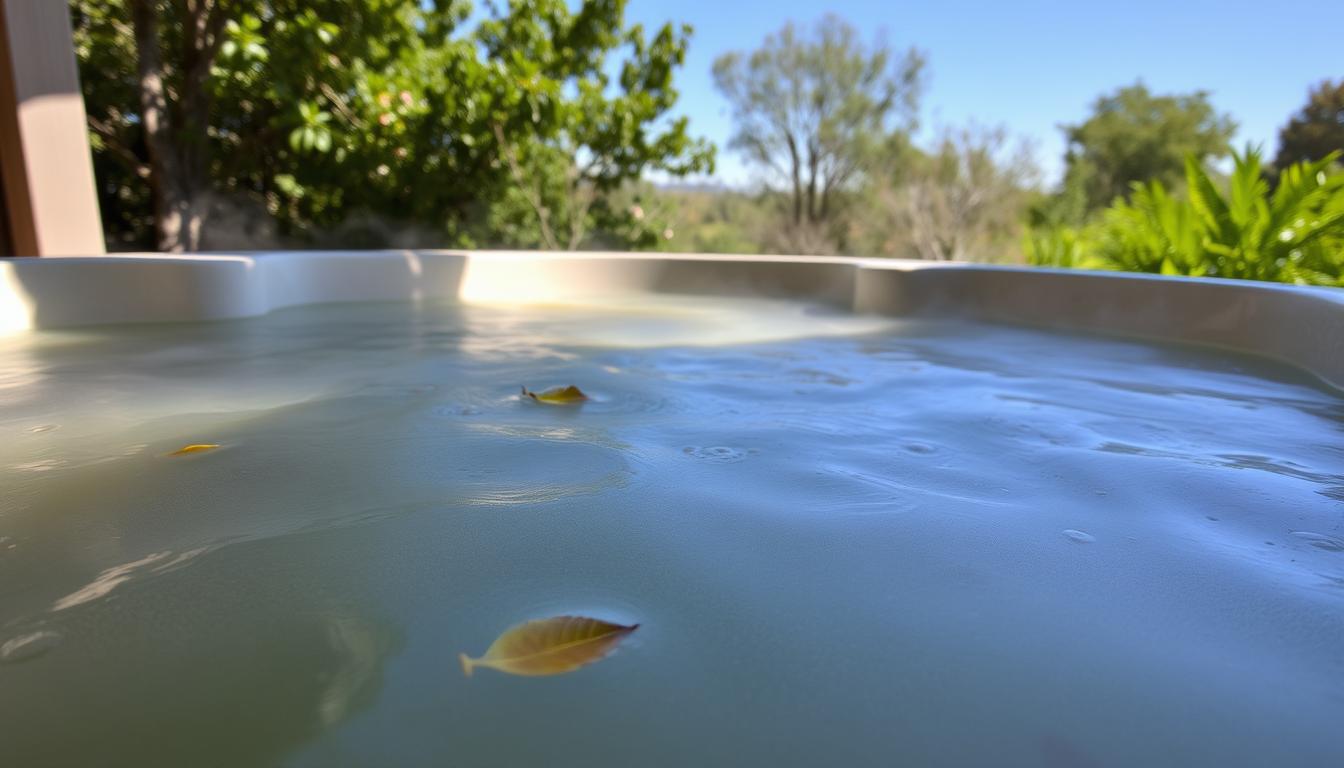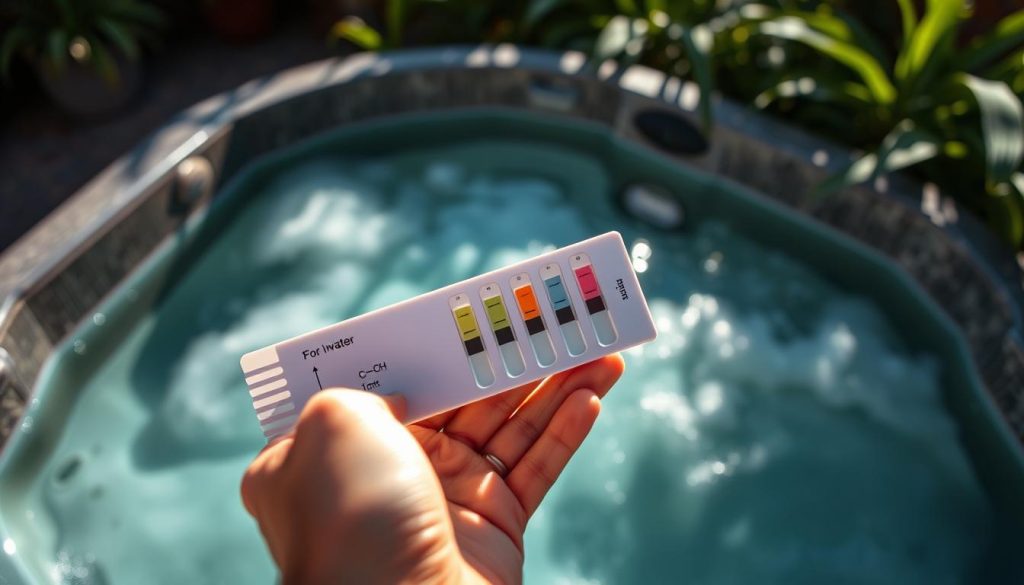
Cloudy water often ruins our hot tub relaxation time. It’s a common problem for many spa owners. Imagine getting ready to unwind, only to find murky water instead of a clear oasis.
Don’t worry! Understanding the causes and solutions can help restore your water’s clarity quickly. Let’s explore how to bring back that crystal-clear sparkle to your hot tub.
Several factors can cause cloudy hot tub water. These include chemical imbalances, poor sanitization, faulty filtration, and high bather load. Organic contaminants can also create tiny particles that filters can’t remove.
To maintain clear water, test and adjust your hot tub’s chemistry regularly. Keep pH levels between 7.2 and 7.8. Ensure total alkalinity stays within 100-150 ppm.
We’ll explore common causes of cloudy water and provide practical solutions. You’ll learn about shocking treatments, filter maintenance, and using clarifiers and flocculants.
By the end, you’ll know how to keep your hot tub water inviting. Get ready to enjoy refreshing, crystal-clear soaks whenever you want!
Common Causes of Cloudy Hot Tub Water
Cloudy hot tub water can be frustrating for owners. It makes the tub less appealing and signals underlying problems. Let’s explore the main causes and how to fix them.
Chemical Imbalances
Chemical imbalances often cause cloudy hot tub water. The ideal pH range is 7.2 to 7.5. Alkalinity should be between 80 to 120 ppm.
When these levels are off, it can lead to cloudy water. It may also cause scale formation or equipment corrosion.
Insufficient Sanitization
Proper sanitizer levels prevent bacterial growth and keep water clear. Chlorine levels should be 3 to 5 ppm. Bromine should be 4 to 6 ppm.
Low sanitization allows contaminants to thrive, causing cloudy water. Regular testing and adjusting of sanitizer levels is crucial.
Poor Filtration
The filtration system removes particles and debris from the water. Dirty or clogged filters can hinder proper water circulation. This leads to cloudy water.
Rinse filters weekly and clean them monthly. Replace them yearly. Neglecting filter maintenance can cause buildup of contaminants.
High Bather Load and Contaminants
Frequent hot tub use can introduce contaminants like lotions and oils. These substances react with water alkalinity, creating a foamy appearance.
Ask bathers to rinse off before entering the hot tub. Consider using enzyme solutions to break down organic contaminants more efficiently.
| Parameter | Ideal Range | Effect on Water Clarity |
|---|---|---|
| pH | 7.2 – 7.5 | Imbalanced pH can lead to cloudy water and other issues |
| Alkalinity | 80 – 120 ppm | Proper alkalinity helps maintain stable pH and clear water |
| Chlorine | 3 – 5 ppm | Adequate sanitizer levels prevent bacterial growth and cloudy water |
| Bromine | 4 – 6 ppm | Proper bromine levels help keep the water clean and clear |
Regular testing and maintaining the right water chemistry, combined with proper filtration and bather hygiene, are key to preventing and resolving cloudy hot tub water issues.
Diagnosing and Treating Cloudy Hot Tub Water
Cloudy hot tub water needs a step-by-step approach to fix. Testing water chemistry, shocking the tub, and cleaning filters can help restore clarity. Using clarifiers or flocculants is also effective.

Testing Water Chemistry
Test water chemistry with strips or a professional analysis. Key parameters have ideal ranges for hot tub water.
| Parameter | Ideal Range |
|---|---|
| pH | 7.2 – 7.8 |
| Alkalinity | 80 – 120 ppm |
| Calcium Hardness | 150 – 250 ppm |
| Chlorine | 1 – 3 ppm |
| Bromine | 3 – 5 ppm |
Test and adjust chemical levels weekly. More frequent testing may be needed with heavy use.
Shocking the Hot Tub
Shocking adds a large dose of sanitizer to break down contaminants. Do this weekly or after heavy use. It helps maintain sanitation and keeps water clean.
Cleaning or Replacing Filters
Filters remove particles and contaminants from the water. Rinse filters weekly and deep clean monthly with a cleaner. Replace filters every 6-12 months, depending on use.
Weekly filter inspection and cleaning removes oil, cosmetics, and debris buildup. This is crucial for maintaining water quality.
Using Clarifiers and Flocculants
Clarifiers coagulate small particles for easier filtration. Flocculants clump particles together, making them sink for vacuuming. Use an algaecide before adding a clarifier for best results.
Establishing good hot tub care habits through consistent maintenance and early intervention is key to preventing water cloudiness issues.
Following these steps ensures a clean, clear, and enjoyable soaking experience. Regular maintenance is key to preventing cloudy water issues.
Why Is Hot Tub Water Cloudy and How to Prevent It
Cloudy hot tub water can be a real headache for owners. It stems from chemical imbalances, poor sanitization, or inadequate filtration. Regular maintenance is key to keeping your water clean and clear.
Proper water chemistry is crucial in preventing cloudiness. Test the water often and adjust pH, alkalinity, and sanitizer levels. Aim for a pH of 7.0-7.6 and total alkalinity of 80-160 mg/l.
For sanitizer levels, maintain 3-5 mg/l for chlorine or 2-4 mg/l for bromine. Using a pre-filter when filling your tub can help reduce contaminants.
Keep your hot tub filters clean and replace them as recommended. This is typically every 12 months. Change the water every 3-4 months to prevent dissolved solids buildup.
Use a hot tub cover when not in use. This helps keep out debris and pollutants. Following these steps will help you enjoy crystal-clear water in your hot tub.







